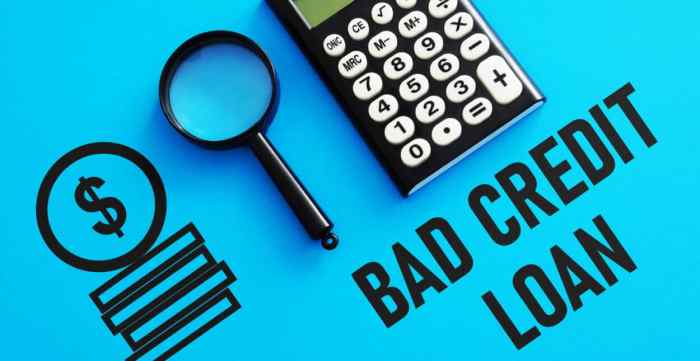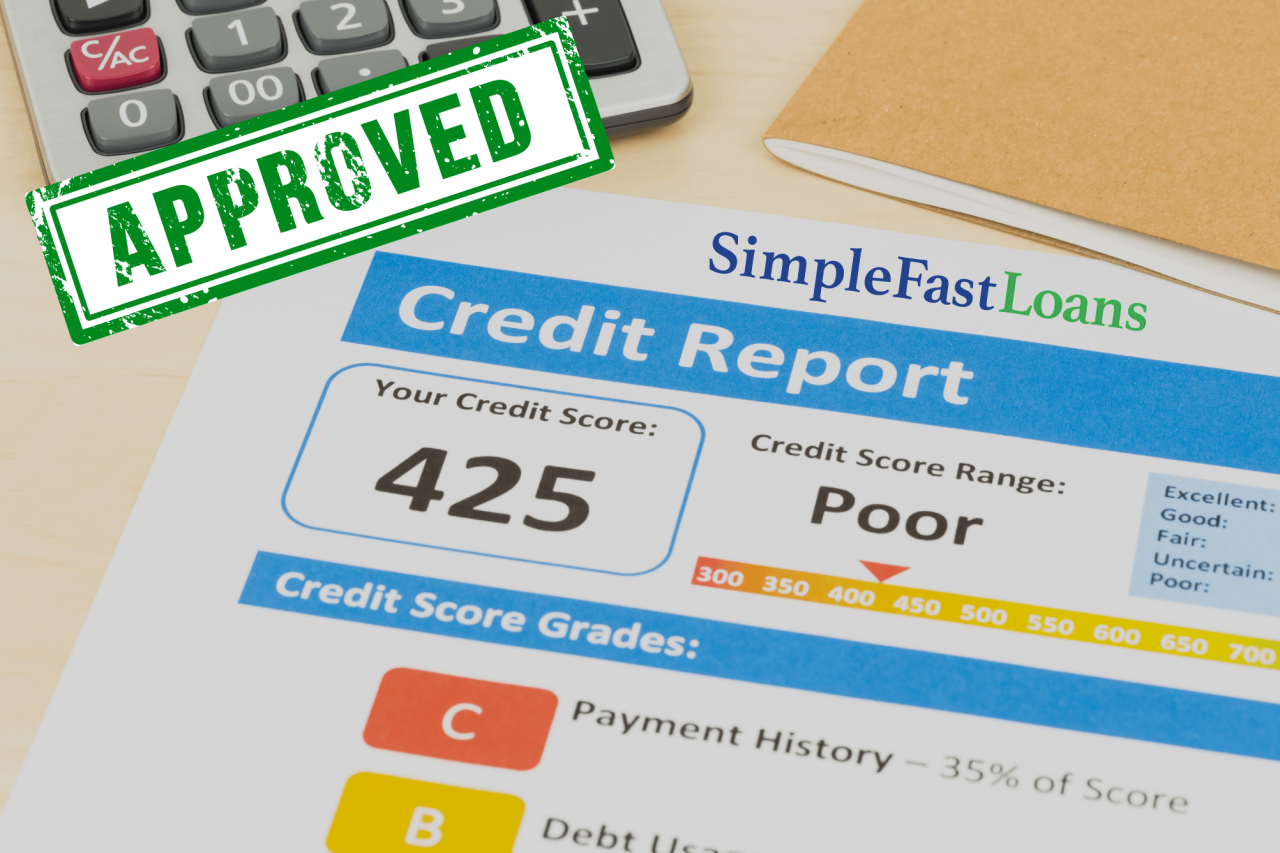Bad credit loans Understanding Options and Solutions
Bad credit loans are financial products designed to assist individuals with poor credit histories in obtaining the funds they need. These loans serve as a vital resource for those who may otherwise struggle to secure financing through traditional lending methods. Understanding the nature of bad credit loans is essential, as it empowers borrowers to make informed decisions regarding their financial futures.
The world of bad credit loans encompasses various types and lenders, offering solutions tailored to different financial needs. By exploring the eligibility criteria, application processes, and associated risks, borrowers can navigate this challenging landscape with greater confidence and clarity.
Understanding Bad Credit Loans
Bad credit loans are financial products designed for individuals with poor credit histories, often marked by late payments, defaults, or high levels of existing debt. These loans serve the purpose of providing access to funding for those who may be unable to secure traditional loans from banks or credit unions due to their credit rating. This type of lending is crucial as it helps borrowers manage their finances, consolidate debts, or cover unexpected expenses, thereby giving them a chance to rebuild their credit score over time.Bad credit loans can be categorized into two main types: secured and unsecured loans.
A secured bad credit loan requires the borrower to put up collateral, such as a vehicle or property, which the lender can claim if the borrower fails to repay the loan. These loans typically offer lower interest rates due to the reduced risk associated with collateral. In contrast, unsecured bad credit loans do not require any collateral, making them more accessible but often resulting in higher interest rates.
Borrowers are assessed based on their creditworthiness, income, and repayment ability rather than an asset they possess.
Eligibility Criteria for Bad Credit Loans
The eligibility criteria for obtaining bad credit loans can vary significantly by lender, but there are common factors that are generally considered. Understanding these criteria is essential for potential borrowers as it helps them prepare and enhance their chances of approval.
- Credit Score: Most lenders have a minimum credit score requirement, often starting at 300, but many prefer scores of 580 or higher.
- Income Verification: Lenders typically require proof of steady income, which can be demonstrated through pay slips, bank statements, or tax returns to ensure the borrower can meet repayment obligations.
- Employment Status: Being employed or having a stable source of income is crucial, as it indicates financial reliability and the ability to repay the loan.
- Debt-to-Income Ratio: Lenders will assess the borrower’s debt-to-income ratio to determine how much of their income is already committed to existing debts, helping to gauge their capacity to take on additional debt.
- Residency Status: Some lenders may require borrowers to be permanent residents or citizens, while others might be more flexible.
Meeting these criteria does not guarantee loan approval, but understanding them can help borrowers make informed decisions and possibly improve their creditworthiness in the eyes of lenders. It’s advisable for potential borrowers to shop around and compare offers, as terms and conditions can vary significantly among different lenders.
Types of Bad Credit Loans

Bad credit loans are designed for individuals who may have a less-than-perfect credit history and thus face challenges in securing traditional financing. Understanding the various types of bad credit loans available is essential for those in need of financial assistance. These loans can provide quick access to funds, but it is crucial to be aware of their characteristics, terms, and potential implications.Several types of bad credit loans cater to individuals with poor credit ratings.
Each type serves specific needs and comes with unique terms and conditions. Below are the primary categories of bad credit loans that borrowers may consider:
Personal Loans for Bad Credit, Bad credit loans
Personal loans for bad credit are unsecured loans that provide borrowers with a lump sum of money that can be repaid over time. These loans are often offered by online lenders, credit unions, and peer-to-peer lending platforms. The interest rates may be higher than standard personal loans, reflecting the increased risk associated with lending to individuals with poor credit. Some examples of lenders that provide bad credit personal loans include:
- Avant: Known for its flexible lending criteria and quick application process, Avant offers personal loans with varying amounts and terms.
- OneMain Financial: This lender provides personal loans with a focus on individuals with bad credit, offering both secured and unsecured options.
- Upstart: Upstart utilizes alternative data to assess creditworthiness, making it possible for those with thin credit files to secure personal loans.
Payday Loans
Payday loans are short-term, high-interest loans intended to cover immediate expenses until the borrower receives their next paycheck. These loans are typically small amounts and are often due on the borrower’s next payday. Payday loans are characterized by:
- High Interest Rates: Payday loans often come with exorbitant interest rates, leading to a high cost of borrowing.
- Short Repayment Terms: Borrowers are usually required to repay the loan within two to four weeks.
- Minimal Qualification Requirements: Lenders may not consider the borrower’s credit score, making payday loans accessible to those with bad credit.
It is important to note that while payday loans may provide quick cash, they can lead to a cycle of debt if not managed properly. Borrowers should consider all their options and the potential consequences before opting for this type of loan.
Pros and Cons of Bad Credit Loans

Bad credit loans serve as a financial tool for individuals facing credit challenges. They can provide much-needed access to funds when other options are limited. However, like any financial product, these loans come with their own set of advantages and disadvantages that borrowers should carefully consider before proceeding.
Advantages of Bad Credit Loans
Bad credit loans offer several benefits that can be advantageous for borrowers in need of immediate financial assistance. These advantages include:
- Accessibility: Bad credit loans are typically easier to obtain than traditional loans. Lenders focus more on the borrower’s current financial situation rather than solely on their credit history.
- Quick Approval: Many lenders provide fast approval processes, allowing borrowers to access funds quickly, which can be crucial during financial emergencies.
- Variety of Loan Options: Borrowers can choose from various loan types, including personal loans, payday loans, and installment loans, tailored to their specific needs.
- Improving Credit Score: Timely repayments on bad credit loans can help improve the borrower’s credit score, potentially leading to better financing options in the future.
Disadvantages of Bad Credit Loans
Despite their advantages, bad credit loans can also come with significant drawbacks that borrowers must be aware of. These disadvantages include:
- Higher Interest Rates: Bad credit loans often come with higher interest rates compared to traditional loans, making them more expensive over time.
- Shorter Repayment Terms: Many bad credit loans have shorter repayment periods, which can lead to higher monthly payments and financial strain.
- Risk of Debt Cycle: Borrowers might find themselves in a cycle of debt, especially if they take out multiple loans to cover existing debts.
- Predatory Lending Practices: Some lenders may take advantage of borrowers with poor credit, imposing unfair terms and conditions.
Comparison with Traditional Loans
When comparing bad credit loans to traditional loans, several key differences emerge, particularly in terms of interest rates and loan terms.
| Aspect | Bad Credit Loans | Traditional Loans |
|---|---|---|
| Interest Rates | Higher, often exceeding 30% APR | Lower, generally ranging from 3% to 10% APR |
| Repayment Terms | Shorter, typically 1 to 5 years | Longer, often 10 to 30 years |
| Approval Process | Less stringent, focused on current income and situation | More stringent, heavily reliant on credit history |
Understanding these aspects can help borrowers make informed decisions regarding their financial options. Overall, while bad credit loans can provide necessary support, they also require careful consideration of their long-term implications.
Application Process for Bad Credit Loans
The application process for bad credit loans is a critical step that requires careful attention to detail and preparation. Understanding the steps involved can help borrowers navigate the complexities of securing funding despite a less-than-perfect credit history. This overview will detail the necessary steps, documentation, and tips to enhance the likelihood of loan approval.
Steps Involved in Applying for a Bad Credit Loan
The application process typically involves several essential steps that borrowers need to follow to secure a bad credit loan. Understanding each step can help streamline the process.
1. Research Lenders
Begin by researching lenders who specialize in bad credit loans. Look for reputable institutions that offer favorable terms.
2. Prequalification
Many lenders allow potential borrowers to prequalify by providing basic information about their financial situation. This step can give an idea of potential loan amounts and interest rates without affecting credit scores.
3. Gather Documentation
Collect necessary documentation to support your application. This typically includes proof of income, identification, and credit history.
4. Submit Application
Complete the application form provided by the lender, ensuring that all information is accurate and comprehensive.
5. Review Loan Terms
Once approved, carefully review the loan terms, including interest rates, repayment schedules, and any additional fees.
6. Accept the Offer
If satisfied with the terms, accept the loan offer and complete any final paperwork required by the lender.
7. Receive Funds
After acceptance, the lender will disburse the funds, often through direct deposit.
Documentation Required for the Application Process
Providing the right documentation is vital for a smooth application process. The following documents are typically required when applying for a bad credit loan:
Identification
A government-issued ID, such as a driver’s license or passport, is necessary to verify identity.
Proof of Income
To enhance your financial growth, considering investment planning is vital. This process involves assessing your financial situation and establishing a tailored investment strategy that aligns with your objectives. With the right guidance, you can confidently make informed decisions that pave the way for a secure financial future.
Lenders require proof of income to ascertain the borrower’s ability to repay the loan. This can include pay stubs, bank statements, or tax returns.
Credit History
Although bad credit loans are available to individuals with poor credit, lenders may still request a credit report to understand the borrower’s credit situation.
Bank Statements
Recent bank statements help lenders assess financial stability and spending habits.
Tips on Improving Chances of Approval for Bad Credit Loans
Enhancing the chances of loan approval involves strategic preparation and an understanding of lender expectations. The following tips can significantly improve a borrower’s prospects:
Check Credit Report
Before applying, review your credit report for inaccuracies or discrepancies. Correcting errors can improve your credit score.
Provide Detailed Financial Information
Clearly Artikel income, expenses, and any additional sources of income. Lenders appreciate transparency.
Consider a Co-Signer
A co-signer with good credit can enhance the application’s credibility and increase the chances of approval.
Demonstrate Stability
Showing a stable employment history and consistent income can reassure lenders of your ability to repay the loan.
Limit Applications
Submitting multiple applications in a short time can negatively impact your credit score. Focus on a few reputable lenders.
“Preparation and transparency are key factors in securing bad credit loans.”
Interest Rates and Fees

Interest rates and fees associated with bad credit loans play a critical role in determining the total cost of borrowing for individuals with less-than-perfect credit. Understanding how these rates are calculated and the various fees involved can help borrowers make informed financial decisions.Interest rates for bad credit loans are primarily influenced by the borrower’s credit score, income level, and the lender’s policies.
Lenders often perceive individuals with bad credit as higher risk, leading them to charge elevated interest rates to mitigate potential losses. Furthermore, factors such as loan term length and the loan amount can also affect the interest rate offered. As a result, borrowers may encounter rates that range from moderate to extremely high, depending on their individual circumstances.
Common Fees Associated with Bad Credit Loans
When considering bad credit loans, it is essential to be aware of the various fees that can affect the overall cost of the loan. These fees can significantly increase the total amount owed. Below are some common fees associated with bad credit loans:
- Origination Fees: These are charged by lenders for processing the loan application and can range from 1% to 5% of the loan amount.
- Late Payment Fees: If a borrower fails to make a payment on time, lenders may impose penalties that can add up over time.
- Prepayment Penalties: Some lenders charge fees if borrowers pay off their loans early, which can discourage repayment ahead of schedule.
- Administrative Fees: Additional costs may be incurred for administrative tasks, such as document preparation or credit checks.
Understanding these fees is crucial for borrowers as they can substantially impact the total cost of the loan, leading to a much higher repayment amount than anticipated.
Comparison of Interest Rates from Various Lenders
To provide clarity on the interest rates available for bad credit loans, the following table compares rates from various lenders. It is important to note that actual rates may vary based on individual financial profiles and lender criteria.
| Lender | Interest Rate Range (%) | Loan Amount Range ($) |
|---|---|---|
| Lender A | 10% – 25% | $1,000 – $10,000 |
| Lender B | 15% – 30% | $500 – $5,000 |
| Lender C | 20% – 35% | $2,000 – $15,000 |
| Lender D | 25% – 40% | $1,500 – $20,000 |
When comparing these rates, it is essential for borrowers to not only consider the interest rate but also the associated fees and the total repayment amount to fully understand the financial implications of taking out a bad credit loan.
Alternatives to Bad Credit Loans
For individuals facing the challenges of bad credit, exploring alternatives to traditional bad credit loans can provide viable financial solutions. These alternatives often come with more favorable terms and lower risk, making them suitable options for those in need. Understanding these alternatives can empower borrowers to make informed decisions about their financial health.
Credit Counseling Services
Credit counseling services play a crucial role in helping individuals manage their debts and improve their financial situations. These nonprofit organizations offer expert guidance and resources to assist clients in navigating their financial challenges. Through credit counseling, individuals can receive personalized plans that cater to their financial needs and circumstances.The importance of credit counseling services can be summarized as follows:
- Assessment of Financial Situation: Credit counselors conduct a thorough evaluation of the individual’s financial standing, including income, expenses, and debts.
- Debt Management Plans: Clients can work with counselors to create structured repayment plans that consolidate debts into manageable monthly payments.
- Budgeting Assistance: Counselors provide tools and strategies for effective budgeting, helping clients prioritize spending and save for future needs.
- Financial Education: Workshops and resources offer valuable information on credit management, saving strategies, and responsible borrowing.
Peer-to-Peer Lending
Peer-to-peer (P2P) lending has emerged as an innovative financing option for individuals with bad credit. This method connects borrowers directly with individual investors through online platforms, bypassing traditional financial institutions. As a result, borrowers may find more flexible terms and competitive interest rates compared to conventional lenders.Key aspects of peer-to-peer lending include:
- Direct Interaction: Borrowers can present their stories and financial needs to potential lenders, allowing for a more personal connection and understanding.
- Flexible Loan Amounts: P2P platforms often accommodate a range of loan sizes, making it easier for borrowers to request only what they need.
- Variety of Interest Rates: Interest rates can vary based on the individual’s credit score and risk profile, giving borrowers the chance to secure better rates than traditional loans.
- Quick Access to Funds: The application process is typically faster than traditional lending, enabling borrowers to access funds more promptly.
“Peer-to-peer lending can provide an opportunity for individuals with bad credit to secure financing while fostering a community of investment and support.”
Managing Bad Credit Loans
Managing bad credit loans requires a well-thought-out approach to ensure successful repayment and financial stability. By implementing effective strategies and understanding the importance of budgeting, individuals can regain control over their financial situation. This section Artikels key methods for managing bad credit loans while highlighting valuable resources for financial education and support.
Strategies for Managing Bad Credit Loans
Creating a structured repayment plan is vital for managing bad credit loans effectively. A well-defined strategy can help borrowers mitigate the risks associated with high-interest rates and potential financial pitfalls. Consider the following strategies:
- Prioritize Payments: Focus on high-interest loans first to reduce the overall debt burden. This approach minimizes the amount paid in interest over time.
- Set Up Automatic Payments: Automating payments can help ensure that you never miss a due date, thus avoiding late fees and further damage to your credit score.
- Negotiate with Lenders: Engaging with lenders may yield opportunities to adjust payment terms or lower interest rates, especially if your financial situation improves.
- Consider Debt Consolidation: Combining multiple loans into a single loan with a lower interest rate can simplify payments and potentially reduce monthly obligations.
The Importance of Budgeting
Budgeting plays a crucial role in managing bad credit loans. A well-crafted budget helps individuals track their income and expenses, ensuring that funds are allocated appropriately for loan repayments. By establishing a budget, borrowers can:
- Identify Spending Habits: Understand where money is being spent and identify areas where cuts can be made.
- Allocate Funds for Loan Payments: Designate a specific portion of income for loan payments, which helps in staying on track with repayment schedules.
- Prepare for Emergencies: Build an emergency fund to cover unexpected expenses, preventing the need to rely on additional loans.
Resources for Financial Education and Support
Accessing educational resources can provide guidance and support for effectively managing bad credit loans. Various organizations and online platforms offer helpful information, including:
- Nonprofit Credit Counseling Services: Organizations like the National Foundation for Credit Counseling (NFCC) provide free or low-cost advice on debt management and budgeting.
- Financial Literacy Programs: Many community organizations and libraries offer workshops or courses on personal finance, budgeting, and credit management.
- Online Resources: Websites such as the Consumer Financial Protection Bureau (CFPB) offer tools and information on managing loans, understanding credit scores, and avoiding debt traps.
Impact on Credit Score
Taking out a bad credit loan can have significant implications for an individual’s credit score. Understanding how these loans affect credit ratings and the subsequent financial health is crucial for anyone considering this option. Responsible repayment of such loans can lead to improvements in credit scores over time, while mismanagement can exacerbate financial difficulties.Repaying a bad credit loan has the potential to positively influence credit scores.
Each timely payment contributes to building a positive payment history, which is a key factor in credit scoring models. Conversely, missed payments can have a deleterious effect on credit scores, leading to further financial hurdles.
Engaging in financial planning services is essential for achieving long-term financial stability. These services offer personalized strategies that cater to individual goals, helping clients navigate their financial landscape effectively. By combining expertise with a friendly approach, financial planners ensure that each client feels supported and informed throughout their financial journey.
Long-term Implications of Bad Credit Loans
The long-term implications of bad credit loans extend beyond immediate financial relief. Over time, successfully managing these loans can foster a path toward improved credit health. The continued use of bad credit loans without diligent repayment can lead to a cycle of debt and deteriorating credit scores. The following points highlight potential outcomes of managing bad credit loans:
- Improved Payment History: Consistent repayment builds a positive payment history, which accounts for approximately 35% of credit scores.
- Debt-to-Income Ratio Management: While taking additional loans can increase total debt, timely repayment can keep the debt-to-income ratio manageable, positively influencing creditworthiness.
- Access to Better Financing Options: A steady increase in credit scores may lead to eligibility for loans with better terms and lower interest rates in the future.
- Potential for Credit Mix Improvement: A diversified credit profile can enhance credit scores. Successfully managing a bad credit loan contributes to this diversification.
Rebuilding Credit After Taking a Bad Credit Loan
Rebuilding credit after obtaining a bad credit loan involves strategic financial management and disciplined repayment practices. Individuals can take proactive steps to improve their credit score post-loan. Key strategies include:
- Consistent Payment Schedule: Establish and adhere to a payment schedule to ensure all dues are settled on time.
- Monitor Credit Reports: Regularly check credit reports for errors or inaccuracies that could negatively affect scores, and dispute any discrepancies promptly.
- Limit New Credit Applications: Avoid applying for new credit lines while managing existing debt to prevent unnecessary inquiries that can impact credit scores.
- Credit Counseling Services: Seek guidance from credit counseling services that can offer personalized plans for managing debt and rebuilding credit.
“Timely payments and responsible borrowing behavior can transform a bad credit loan experience into a stepping stone towards financial recovery.”
Final Summary: Bad Credit Loans
In summary, while bad credit loans can provide essential financial support, it is crucial for borrowers to carefully assess their options and understand the implications of taking on such debt. By employing effective management strategies and seeking alternatives when necessary, individuals can improve their financial situations and work towards rebuilding their credit over time.
Common Queries
What are the typical interest rates for bad credit loans?
Interest rates for bad credit loans can vary widely, typically ranging from 10% to over 30%, depending on the lender and the borrower’s credit profile.
Can I get a bad credit loan without a job?
While it may be challenging, some lenders may offer bad credit loans without employment, but they often require alternative forms of income or collateral.
How quickly can I receive funds from a bad credit loan?
Many lenders offer quick funding options, sometimes as fast as the same day or within 24 hours, after loan approval.
Are there any prepayment penalties for bad credit loans?
Some lenders may impose prepayment penalties, so it is essential to review the loan agreement carefully before signing.
Can bad credit loans help improve my credit score?
If repaid on time, bad credit loans can positively impact your credit score by demonstrating responsible credit behavior.
